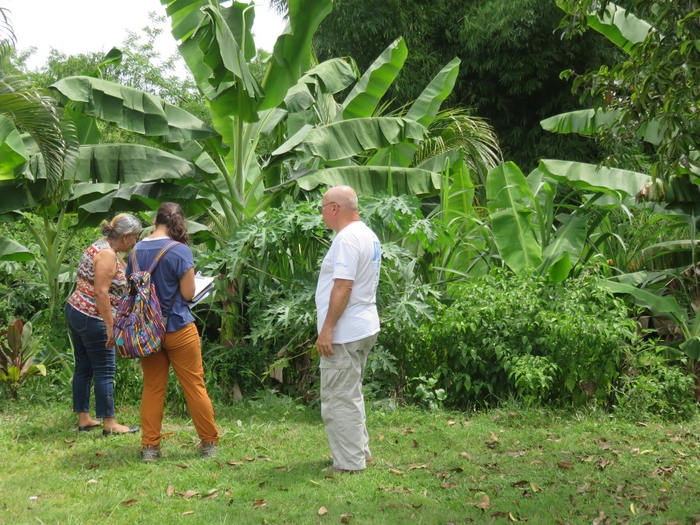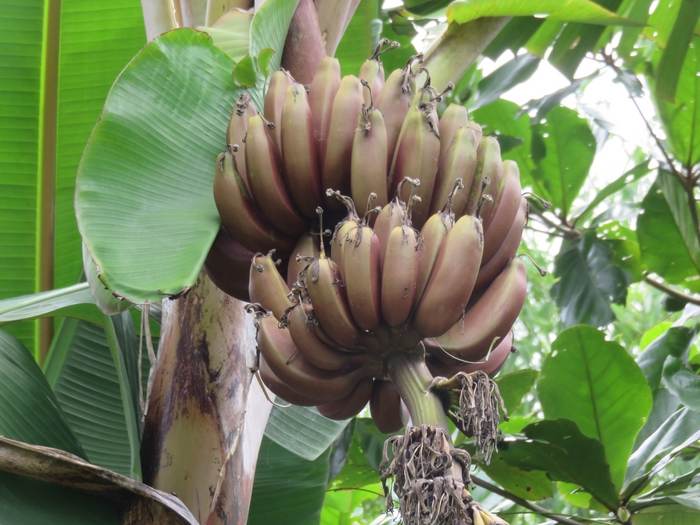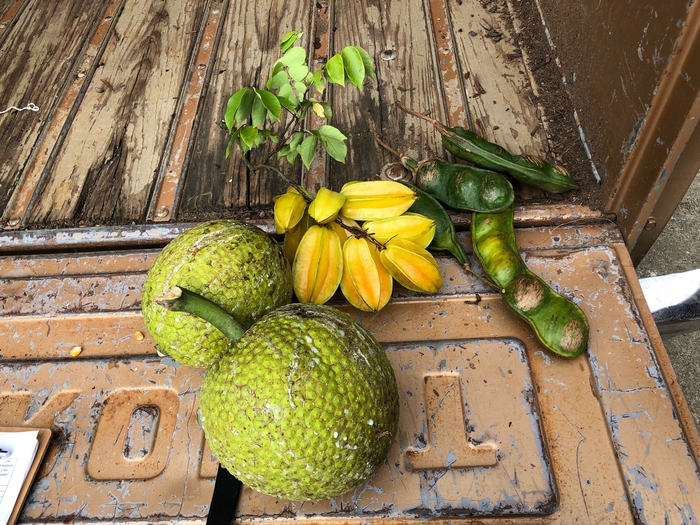Integrating ecology and community management priorities in Río Hondo Community Forest, Puerto Rico
Integrating ecology and community management priorities in Río Hondo Community Forest, Puerto Rico
Gabriela Morales-Nieves, MF 20201
Arriving on the Research Topic
I have always been interested in interdisciplinary research on community-based management of resources, food sovereignty, and agroforestry. I stumbled upon a local news article about a small community forest called Bosque Comunitario de Río Hondo (Río Hondo Community Forest) in Mayagüez, Puerto Rico. The Community and partners were celebrating the recent acquisition of the forest and land title. I was immediately drawn to this community because they were empowered to take ownership of their forest. I hoped to contribute knowledge that could help them develop their forest management and stewardship, while creating practices that could be emulated in other parts of Puerto Rico.
I worked closely with the community and stakeholders, including the director of the Río Hondo Community Forest Board, staff from the US Forest Service, and University of Puerto Rico (UPR) faculty members. After identifying community priorities, I decided to explore two questions: how did the community see their potential role in community-based management, and how coul a vegetative survey of backyard plants and their household uses inform community sustainability. The findings were provided to the current forest management for them to consider community priorities and develop more targeted community engagement and ensure long-term sustainability of the project.
The ecological survey was required to inform local management. Some research has been performed on the status and ecology of forested areas in Puerto Rico, including abandoned agricultural lands (e.g. Rudel et al. 2000, Martinuzzi et al. 2007, Kennaway and Helmer 2007, Parés-Ramos et al. 2008, Castro-Prieto et al. 2019). However, the San Juan Urban Long-Term Research Area (ULTRA) Project was the first to explore the plant ecology of people’s backyards in an urban area. Still, the backyard survey had not been replicated in other parts of Puerto Rico. Accordingly, I followed the socio-ecological research methods used in the ULTRA project (Meléndez-Ackerman et al. 2014, Vila-Ruiz et al. 2014) to study the composition, structure, and diversity of the vegetation in the backyards of residents adjacent to the Río Hondo Community Forest. I also wanted to understand the use of these plants and how these uses can contribute to the community’s sustainability through food security, hazard mitigation, or other ecosystem services.

Fig. 1. Residents that live around the Río Hondo Community Forest showing their backyard plants to me and my research assistant. At times they would explain where they got their plants from and why they planted them.
This research was critical because knowledge about the local flora could help the forest managers make their classes and workshops about plant use more relevant and engaging to the community. More broadly, the study compared data from a “rural-urban interface” in Mayagüez to the San Juan ULTRA Project’s urban data. This comparison provided insight on differences or similarities in the diversity, types, and uses of backyard plants. Data on plant composition and use (particularly for food) can inform how much local food Puerto Ricans consume; it is estimated that currently over 80% of food is imported from outside Puerto Rico (Comas Pagán 2009, Osorio de Jesús 2019). This information is important for policy makers who want to improve food security in Puerto Rico.
The Research Experience and Gathering Data
As an outsider, I needed to build authentic trust because I hoped that people would invite me into their homes for interviews. Thus, I made time to build trust and introduce myself and my intentions to the community. Before gathering data, I visited local schools, went to community activities, and left flyers at people’s homes with my information. Only after this process did I choose a random subset of houses surrounding the forest to conduct interviews. I started my data collection by knocking on doors. I was nervous because I knew that people were giving their time to answer questions and show me their backyards. However, I was received with openness and excitement. People were proud to show their flowering plants and tell me about the fruit trees growing in their yards. Breadfruit, starfruit, avocados, Spanish lime, and many other species were in prime fruiting season and many people were excited to send me home with fruit from their yards.
My favorite part was asking residents what they used their plants for. I felt that this was the question that most residents I interviewed were eager to answer, demonstrating their knowledge on medicinal purposes of a plant, for example, or even superstitious purposes. One interviewee had only one tree in her backyard, a Crescentia cujete (Bignoniaceae), or higüero, as we call them. She explained that she planted it because she was told that if a person made a wish on its flowers on a specific day of the year, that wish would come true. The problem was, that in all the years since the tree had been planted, it had never flowered. On the other hand, only one specimen was planted for wood-harvesting purposes out of all the houses that I visited: a Honduran mahogany tree (Swietenia macrophylla).

Fig. 2. Although not sampled or specifically documented, genetic diversity of plants was an interesting find. For example, although almost all households planted bananas (Musa x paradisiaca), there were a handful of varieties of the same species. In this case, purple bananas were only found in one household.
It was always a box of surprises to enter people’s backyards. Some of them appeared to be small, but the density of plants was enormous. Although many plant species such as banana (Musa x paradisiaca) were common, it was always a treat to find unique specimens such as Ceylon gooseberry (Dovyalis hebecarpa). Gathering data at these residents’ homes felt like a high-speed juggling act of counting specimens, identifying or photographing them, asking the owner their use, measuring diameter at breast height of trees, all while sometimes maintaining conversation with the residents. For species I could not identify in the field, it required taking and examining photographs, patiently researching at home, or working with knowledgeable local botanists.
I’m grateful that so many community members opened their doors and shared a glimpse of their lives with me. Interviewees were also eager to share seeds, flowers, snacks, and most importantly, stories. As we sat in living rooms and on porches, residents shared stories about deceased family members, winning the lottery, growing up in the same community, and migrating to the United States out of necessity and retiring in Puerto Rico to a happy, quiet, and loving home. Though this ethnographic data won’t be in my vegetative analysis, the stories helped me weave together a story (however incomplete) of the community, its history, and the underlying motivations and attachment to place that inspired community members to organize and fight to keep the forest as a protected area.

Fig. 3. Starfruit (Averrhoa carambola), breadfruit (Artocarpus altilis) and “guamá” (Inga nobilis subsp. quaternata) gifted to me during an interview.
Next Steps and Relevance
After such an eventful summer, which included almost being chased by wild horses in the forest, my hope is that in connecting a thread between the forest and its surrounding residents, the social and the ecological, this research can make a small contribution to this small area’s resiliency and sustainability. The full research paper will be published as a case study in a chapter for an upcoming book by YSE researcher Dr. Florencia Montagnini.
Besides contributing to informed management at the local scale for this small community forest, I hope that this analysis will contribute to country-wide knowledge about the status of plant use by residents. This knowledge can help plan more targeted education and extension on plant use and food security based on people’s interests. Finally, including data like these along with information on imports and agricultural production can help provide a more complete picture on the status of food security in Puerto Rico, food access, and health habits of its residents.
References
Castro-Prieto, J. et al. 2019. A Comprehensive Inventory of Protected Areas and other Land Conservation Mechanisms in Puerto Rico. General Technical Report 50.
Comas Pagán, M. 2009. Vulnerabilidad de las cadenas de suministros, el cambio climático y el desarrollo de estrategias de adaptación: El caso de las cadenas de suministros de alimento de Puerto Rico. PhD Thesis, Universidad de Puerto Rico-Recinto de Río Piedras, San Juan, Puerto Rico.
Kennaway, T. and E. H. Helmer. 2007. The Forest Types and Ages Cleared for Land Development in Puerto Rico. GIScience & Remote Sensing 44, 356–382.
Martinuzzi, S. et al. 2007. Land development, land use, and urban sprawl in Puerto Rico integrating remote sensing and population census data. Landscape and Urban Planning 79, 288–297.
Meléndez-Ackerman, E. et al. 2014. Socioeconomic drivers of yard sustainable practices in a tropical city. Ecology and Society 19.
Osorio de Jesús, Í. 2019. La seguridad alimentaria tras María. https://www.uprm.edu/portada/2019/03/01/la-seguridad-alimentaria-tras-ma….
Parés-Ramos, I. et al. 2008. Agricultural Abandonment, Suburban Growth, and Forest Expansion in Puerto Rico between 1991 and 2000. Ecology and Society 13.
Rudel, T. K. et al. 2000. When Fields Revert to Forest: Development and Spontaneous Reforestation in Post-War Puerto Rico. The Professional Geographer 52, 386–397.
Vila-Ruiz, C. et al. 2014. Plant species richness and abundance in residential yards across a tropical watershed: implications for urban sustainability. Ecology and Society 19.
Citation
Morales-Nieves, G. 2020. Integrating ecology and community management priorities in Río Hondo Community Forest, Puerto Rico. Tropical Resources 39, 00–00.
-
short bio↩︎